Adopting Cloud-based OSDS | Assignment
VerifiedAdded on 2022/09/11
|11
|2932
|10
AI Summary
Contribute Materials
Your contribution can guide someone’s learning journey. Share your
documents today.
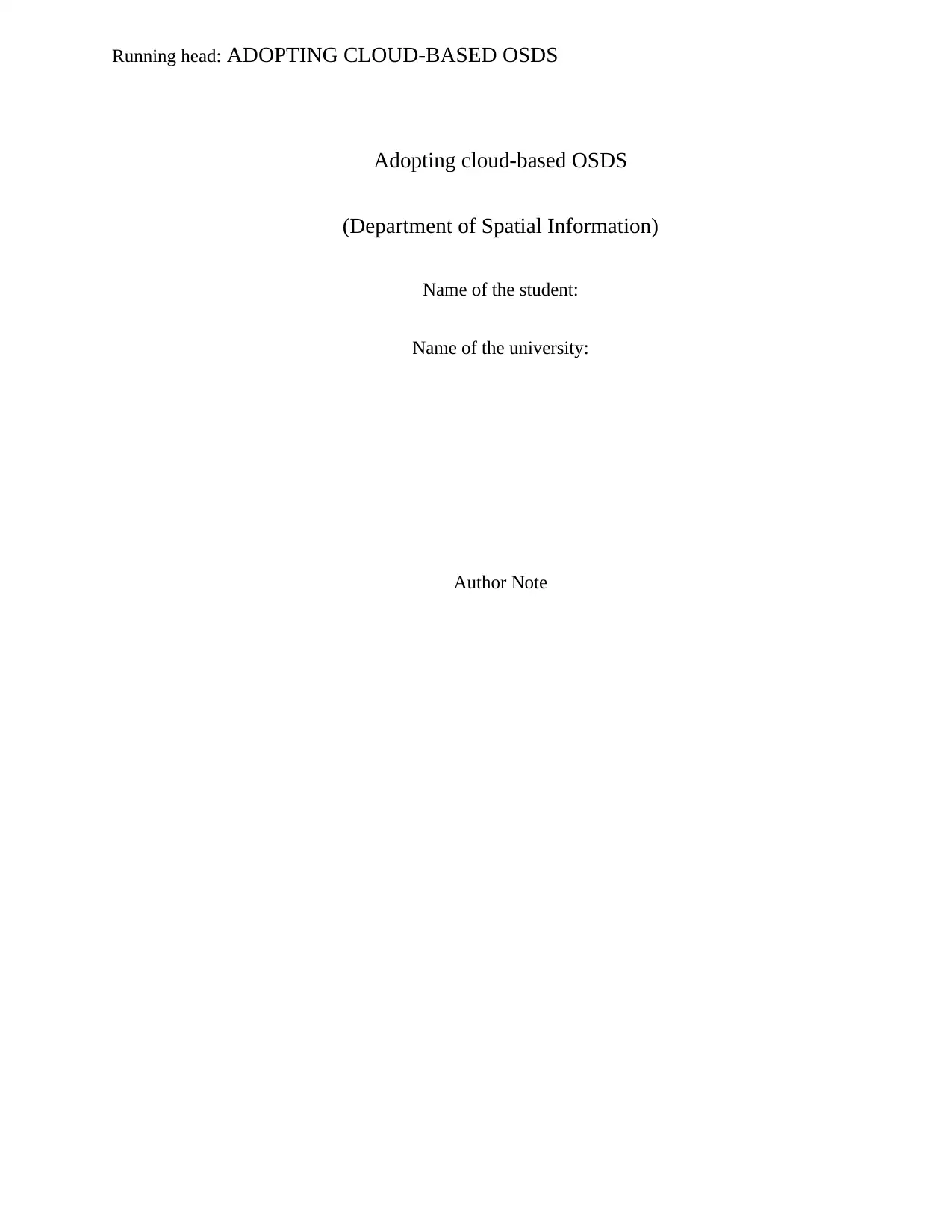
Running head: ADOPTING CLOUD-BASED OSDS
Adopting cloud-based OSDS
(Department of Spatial Information)
Name of the student:
Name of the university:
Author Note
Adopting cloud-based OSDS
(Department of Spatial Information)
Name of the student:
Name of the university:
Author Note
Secure Best Marks with AI Grader
Need help grading? Try our AI Grader for instant feedback on your assignments.
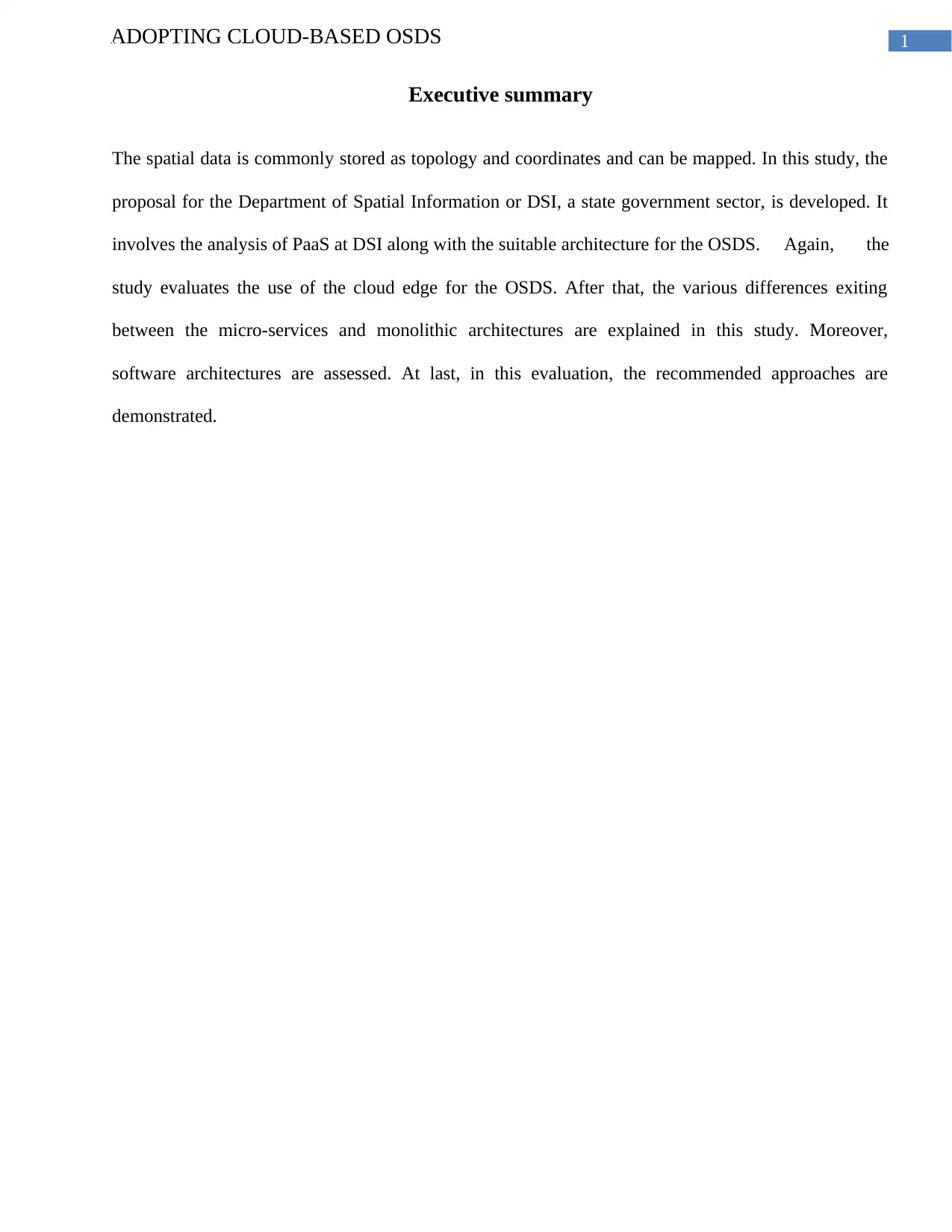
1ADOPTING CLOUD-BASED OSDS
Executive summary
The spatial data is commonly stored as topology and coordinates and can be mapped. In this study, the
proposal for the Department of Spatial Information or DSI, a state government sector, is developed. It
involves the analysis of PaaS at DSI along with the suitable architecture for the OSDS. Again, the
study evaluates the use of the cloud edge for the OSDS. After that, the various differences exiting
between the micro-services and monolithic architectures are explained in this study. Moreover,
software architectures are assessed. At last, in this evaluation, the recommended approaches are
demonstrated.
Executive summary
The spatial data is commonly stored as topology and coordinates and can be mapped. In this study, the
proposal for the Department of Spatial Information or DSI, a state government sector, is developed. It
involves the analysis of PaaS at DSI along with the suitable architecture for the OSDS. Again, the
study evaluates the use of the cloud edge for the OSDS. After that, the various differences exiting
between the micro-services and monolithic architectures are explained in this study. Moreover,
software architectures are assessed. At last, in this evaluation, the recommended approaches are
demonstrated.

2ADOPTING CLOUD-BASED OSDS
Table of Contents
Introduction:..................................................................................................................................................3
1. Understanding possible delivery and models of deployments that must be adopted by DSI for OSDS:. 3
1.a. Benefits and using PaaS approach for OSDS:....................................................................................3
1.b. The possible architecture used to deploy OSDS:...............................................................................4
2. Use of Cloud Edge for OSDS:..................................................................................................................5
3. Case of OSDS software architecture utilizing a monolithic approach towards the deigning:..................6
3.a. Explaining the difference between microservices and monolithic architectures for DSI Board:......6
3.b. Pros and cons of the software as mentioned above architecture styles:.............................................6
4. Approach recommended for the deployment and delivery of OSDS:......................................................7
Conclusion:....................................................................................................................................................8
References:....................................................................................................................................................9
Table of Contents
Introduction:..................................................................................................................................................3
1. Understanding possible delivery and models of deployments that must be adopted by DSI for OSDS:. 3
1.a. Benefits and using PaaS approach for OSDS:....................................................................................3
1.b. The possible architecture used to deploy OSDS:...............................................................................4
2. Use of Cloud Edge for OSDS:..................................................................................................................5
3. Case of OSDS software architecture utilizing a monolithic approach towards the deigning:..................6
3.a. Explaining the difference between microservices and monolithic architectures for DSI Board:......6
3.b. Pros and cons of the software as mentioned above architecture styles:.............................................6
4. Approach recommended for the deployment and delivery of OSDS:......................................................7
Conclusion:....................................................................................................................................................8
References:....................................................................................................................................................9
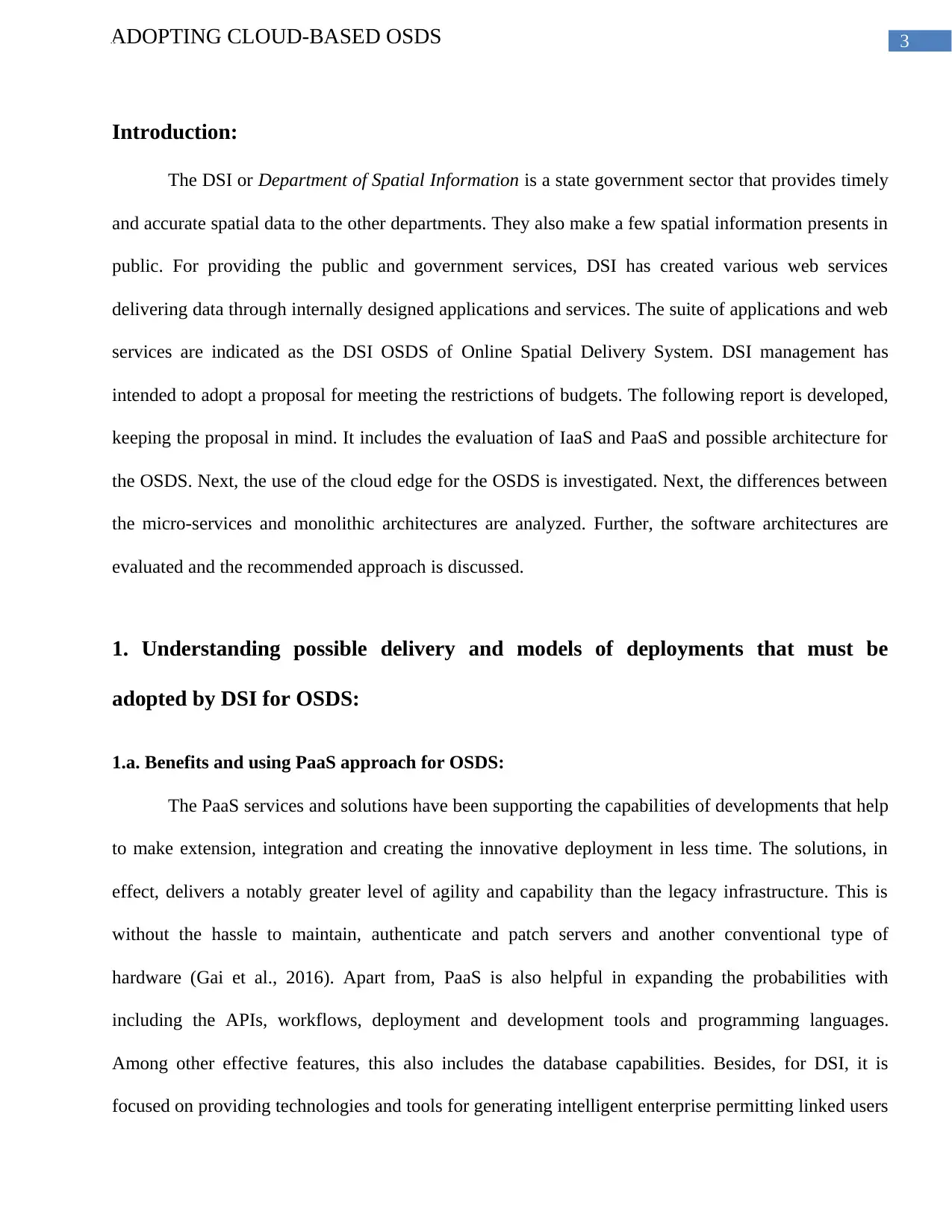
3ADOPTING CLOUD-BASED OSDS
Introduction:
The DSI or Department of Spatial Information is a state government sector that provides timely
and accurate spatial data to the other departments. They also make a few spatial information presents in
public. For providing the public and government services, DSI has created various web services
delivering data through internally designed applications and services. The suite of applications and web
services are indicated as the DSI OSDS of Online Spatial Delivery System. DSI management has
intended to adopt a proposal for meeting the restrictions of budgets. The following report is developed,
keeping the proposal in mind. It includes the evaluation of IaaS and PaaS and possible architecture for
the OSDS. Next, the use of the cloud edge for the OSDS is investigated. Next, the differences between
the micro-services and monolithic architectures are analyzed. Further, the software architectures are
evaluated and the recommended approach is discussed.
1. Understanding possible delivery and models of deployments that must be
adopted by DSI for OSDS:
1.a. Benefits and using PaaS approach for OSDS:
The PaaS services and solutions have been supporting the capabilities of developments that help
to make extension, integration and creating the innovative deployment in less time. The solutions, in
effect, delivers a notably greater level of agility and capability than the legacy infrastructure. This is
without the hassle to maintain, authenticate and patch servers and another conventional type of
hardware (Gai et al., 2016). Apart from, PaaS is also helpful in expanding the probabilities with
including the APIs, workflows, deployment and development tools and programming languages.
Among other effective features, this also includes the database capabilities. Besides, for DSI, it is
focused on providing technologies and tools for generating intelligent enterprise permitting linked users
Introduction:
The DSI or Department of Spatial Information is a state government sector that provides timely
and accurate spatial data to the other departments. They also make a few spatial information presents in
public. For providing the public and government services, DSI has created various web services
delivering data through internally designed applications and services. The suite of applications and web
services are indicated as the DSI OSDS of Online Spatial Delivery System. DSI management has
intended to adopt a proposal for meeting the restrictions of budgets. The following report is developed,
keeping the proposal in mind. It includes the evaluation of IaaS and PaaS and possible architecture for
the OSDS. Next, the use of the cloud edge for the OSDS is investigated. Next, the differences between
the micro-services and monolithic architectures are analyzed. Further, the software architectures are
evaluated and the recommended approach is discussed.
1. Understanding possible delivery and models of deployments that must be
adopted by DSI for OSDS:
1.a. Benefits and using PaaS approach for OSDS:
The PaaS services and solutions have been supporting the capabilities of developments that help
to make extension, integration and creating the innovative deployment in less time. The solutions, in
effect, delivers a notably greater level of agility and capability than the legacy infrastructure. This is
without the hassle to maintain, authenticate and patch servers and another conventional type of
hardware (Gai et al., 2016). Apart from, PaaS is also helpful in expanding the probabilities with
including the APIs, workflows, deployment and development tools and programming languages.
Among other effective features, this also includes the database capabilities. Besides, for DSI, it is
focused on providing technologies and tools for generating intelligent enterprise permitting linked users
Paraphrase This Document
Need a fresh take? Get an instant paraphrase of this document with our AI Paraphraser
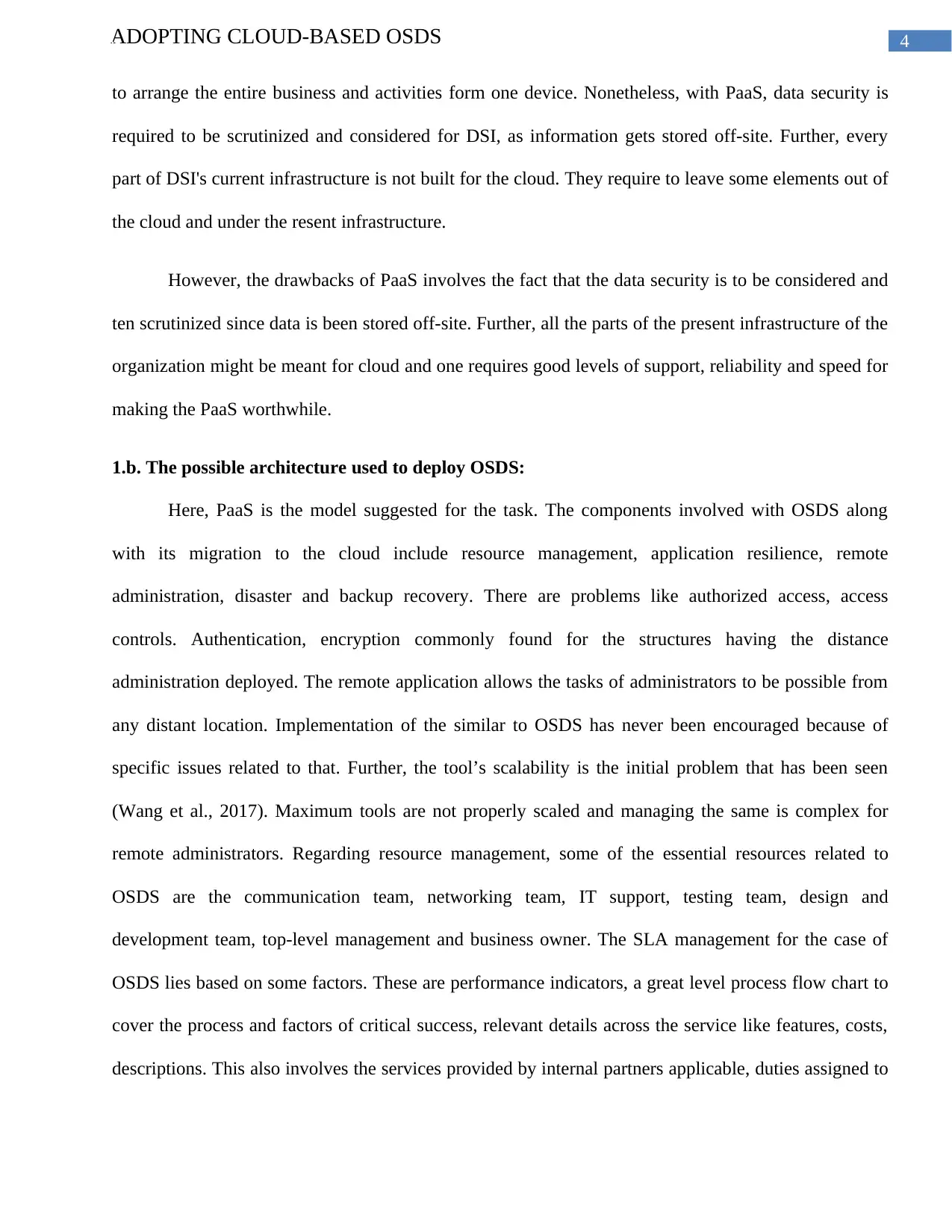
4ADOPTING CLOUD-BASED OSDS
to arrange the entire business and activities form one device. Nonetheless, with PaaS, data security is
required to be scrutinized and considered for DSI, as information gets stored off-site. Further, every
part of DSI's current infrastructure is not built for the cloud. They require to leave some elements out of
the cloud and under the resent infrastructure.
However, the drawbacks of PaaS involves the fact that the data security is to be considered and
ten scrutinized since data is been stored off-site. Further, all the parts of the present infrastructure of the
organization might be meant for cloud and one requires good levels of support, reliability and speed for
making the PaaS worthwhile.
1.b. The possible architecture used to deploy OSDS:
Here, PaaS is the model suggested for the task. The components involved with OSDS along
with its migration to the cloud include resource management, application resilience, remote
administration, disaster and backup recovery. There are problems like authorized access, access
controls. Authentication, encryption commonly found for the structures having the distance
administration deployed. The remote application allows the tasks of administrators to be possible from
any distant location. Implementation of the similar to OSDS has never been encouraged because of
specific issues related to that. Further, the tool’s scalability is the initial problem that has been seen
(Wang et al., 2017). Maximum tools are not properly scaled and managing the same is complex for
remote administrators. Regarding resource management, some of the essential resources related to
OSDS are the communication team, networking team, IT support, testing team, design and
development team, top-level management and business owner. The SLA management for the case of
OSDS lies based on some factors. These are performance indicators, a great level process flow chart to
cover the process and factors of critical success, relevant details across the service like features, costs,
descriptions. This also involves the services provided by internal partners applicable, duties assigned to
to arrange the entire business and activities form one device. Nonetheless, with PaaS, data security is
required to be scrutinized and considered for DSI, as information gets stored off-site. Further, every
part of DSI's current infrastructure is not built for the cloud. They require to leave some elements out of
the cloud and under the resent infrastructure.
However, the drawbacks of PaaS involves the fact that the data security is to be considered and
ten scrutinized since data is been stored off-site. Further, all the parts of the present infrastructure of the
organization might be meant for cloud and one requires good levels of support, reliability and speed for
making the PaaS worthwhile.
1.b. The possible architecture used to deploy OSDS:
Here, PaaS is the model suggested for the task. The components involved with OSDS along
with its migration to the cloud include resource management, application resilience, remote
administration, disaster and backup recovery. There are problems like authorized access, access
controls. Authentication, encryption commonly found for the structures having the distance
administration deployed. The remote application allows the tasks of administrators to be possible from
any distant location. Implementation of the similar to OSDS has never been encouraged because of
specific issues related to that. Further, the tool’s scalability is the initial problem that has been seen
(Wang et al., 2017). Maximum tools are not properly scaled and managing the same is complex for
remote administrators. Regarding resource management, some of the essential resources related to
OSDS are the communication team, networking team, IT support, testing team, design and
development team, top-level management and business owner. The SLA management for the case of
OSDS lies based on some factors. These are performance indicators, a great level process flow chart to
cover the process and factors of critical success, relevant details across the service like features, costs,
descriptions. This also involves the services provided by internal partners applicable, duties assigned to

5ADOPTING CLOUD-BASED OSDS
tea and members of the project, team of supply chain management and agreed-on and negotiated
service design between the cloud provider and DSI.
2. Use of Cloud Edge for OSDS:
The most significant advantage of edge computing is the development of network performance
through decreasing latency. For OSDS, the CloudEdge solution would be optimizing and developing
support of application software. This is to deliver cloud-based benefits like elastic scaling and
automatic deployments. This is to meet requirements of carrier-grade regarding O&M, performance
and availability. Firstly, front-end architecture is to be considered. The front end s visible to the client,
user and customers the pieces involves user interface and computer system and network of client that
can be used for accessing the cloud system (Welsh & Benkhelifa, 2018). Secondly, the back end of
cloud computing architecture is to be considered. The back-end prices, on the other hand re on side
utilized by service providers. It involves different data storage systems, virtual machines, computers,
servers and programs that constitute the cloud of the computing services altogether. It is responsible for
delivering traffic control, protocols and security mechanisms connecting networked systems for
communications (Díaz, Martín & Rubio, 2016).
However, regarding disadvantages, the security is a problem on edge. Edge computing in the
case applications need requirements of low security. On the other hand, in cloud things are required to
be controlled and must comprise of high-security requirements (Abdel-Basset, Mohamed & Chang,
2018). Further, it processes and assesses just the subset of data. This discards incomplete insights and
raw information. Here, the business must take into consideration about what level of data loss is been
acceptable. Moreover, this raises the attack vectors. Having the addition of IoT, the built-in computer
and devices, the scopes raises for malicious hackers and attackers for infiltrating devices and ten make
access to the sensitive data. Again edge computing needs much more local hardware.
tea and members of the project, team of supply chain management and agreed-on and negotiated
service design between the cloud provider and DSI.
2. Use of Cloud Edge for OSDS:
The most significant advantage of edge computing is the development of network performance
through decreasing latency. For OSDS, the CloudEdge solution would be optimizing and developing
support of application software. This is to deliver cloud-based benefits like elastic scaling and
automatic deployments. This is to meet requirements of carrier-grade regarding O&M, performance
and availability. Firstly, front-end architecture is to be considered. The front end s visible to the client,
user and customers the pieces involves user interface and computer system and network of client that
can be used for accessing the cloud system (Welsh & Benkhelifa, 2018). Secondly, the back end of
cloud computing architecture is to be considered. The back-end prices, on the other hand re on side
utilized by service providers. It involves different data storage systems, virtual machines, computers,
servers and programs that constitute the cloud of the computing services altogether. It is responsible for
delivering traffic control, protocols and security mechanisms connecting networked systems for
communications (Díaz, Martín & Rubio, 2016).
However, regarding disadvantages, the security is a problem on edge. Edge computing in the
case applications need requirements of low security. On the other hand, in cloud things are required to
be controlled and must comprise of high-security requirements (Abdel-Basset, Mohamed & Chang,
2018). Further, it processes and assesses just the subset of data. This discards incomplete insights and
raw information. Here, the business must take into consideration about what level of data loss is been
acceptable. Moreover, this raises the attack vectors. Having the addition of IoT, the built-in computer
and devices, the scopes raises for malicious hackers and attackers for infiltrating devices and ten make
access to the sensitive data. Again edge computing needs much more local hardware.

6ADOPTING CLOUD-BASED OSDS
3. Case of OSDS software architecture utilizing a monolithic approach towards the
deigning:
3.a. Explaining the difference between microservices and monolithic architectures for DSI Board:
The microservices comprise a serious level of transformational capabilities. They stand for
accelerating development. However, they are never always a suitable fit for all types of organizations.
They actually function well for the business that has embraced CI/CD, DevOps and Agile. This culture
of decentralized decision-making empowers small groups to move fast (Kritikos et al., 2017). For the
case of DSI, the monolithic application can be a better option. As the instance are small, for example,
they adopt the distributed architecture such as microservices prior that is needed results in overly
complicated application and rise in overhead. DSI can consider to develop a new app from scratch and
develop the proof of the idea beneficial from accepting monolith. This might be counterintuitive and
small monoliths have been cost-effective with an uncomplicated solution. It is simple in terms of
understanding and to debug test and scale (Yang et al., 2017). Since, the conventional architecture has
been discussed, that never indicates the monoliths have been relegated to use previous technologies.
Here, the main thing to be remembered is that this has been until monoliths to expand beyond the main
abilities making sense of making that migration (Hussein & Khalid, 2016). Furthermore, as this
application develops, the thing that makes the architecture to be an appealing solution is the simple
development and low costs and so on. It has been coming at the cost of speed security, flexibility and
scale.
3.b. Pros and cons of the software as mentioned above architecture styles:
The monolithic architecture is simple to develop, test, deploy and scale horizontally. However,
the drawbacks lie in the fact that it has a limitation in complexity and size. This application is complex
and large to understand and make changes correctly and fast totally and the size slows down the time of
3. Case of OSDS software architecture utilizing a monolithic approach towards the
deigning:
3.a. Explaining the difference between microservices and monolithic architectures for DSI Board:
The microservices comprise a serious level of transformational capabilities. They stand for
accelerating development. However, they are never always a suitable fit for all types of organizations.
They actually function well for the business that has embraced CI/CD, DevOps and Agile. This culture
of decentralized decision-making empowers small groups to move fast (Kritikos et al., 2017). For the
case of DSI, the monolithic application can be a better option. As the instance are small, for example,
they adopt the distributed architecture such as microservices prior that is needed results in overly
complicated application and rise in overhead. DSI can consider to develop a new app from scratch and
develop the proof of the idea beneficial from accepting monolith. This might be counterintuitive and
small monoliths have been cost-effective with an uncomplicated solution. It is simple in terms of
understanding and to debug test and scale (Yang et al., 2017). Since, the conventional architecture has
been discussed, that never indicates the monoliths have been relegated to use previous technologies.
Here, the main thing to be remembered is that this has been until monoliths to expand beyond the main
abilities making sense of making that migration (Hussein & Khalid, 2016). Furthermore, as this
application develops, the thing that makes the architecture to be an appealing solution is the simple
development and low costs and so on. It has been coming at the cost of speed security, flexibility and
scale.
3.b. Pros and cons of the software as mentioned above architecture styles:
The monolithic architecture is simple to develop, test, deploy and scale horizontally. However,
the drawbacks lie in the fact that it has a limitation in complexity and size. This application is complex
and large to understand and make changes correctly and fast totally and the size slows down the time of
Secure Best Marks with AI Grader
Need help grading? Try our AI Grader for instant feedback on your assignments.
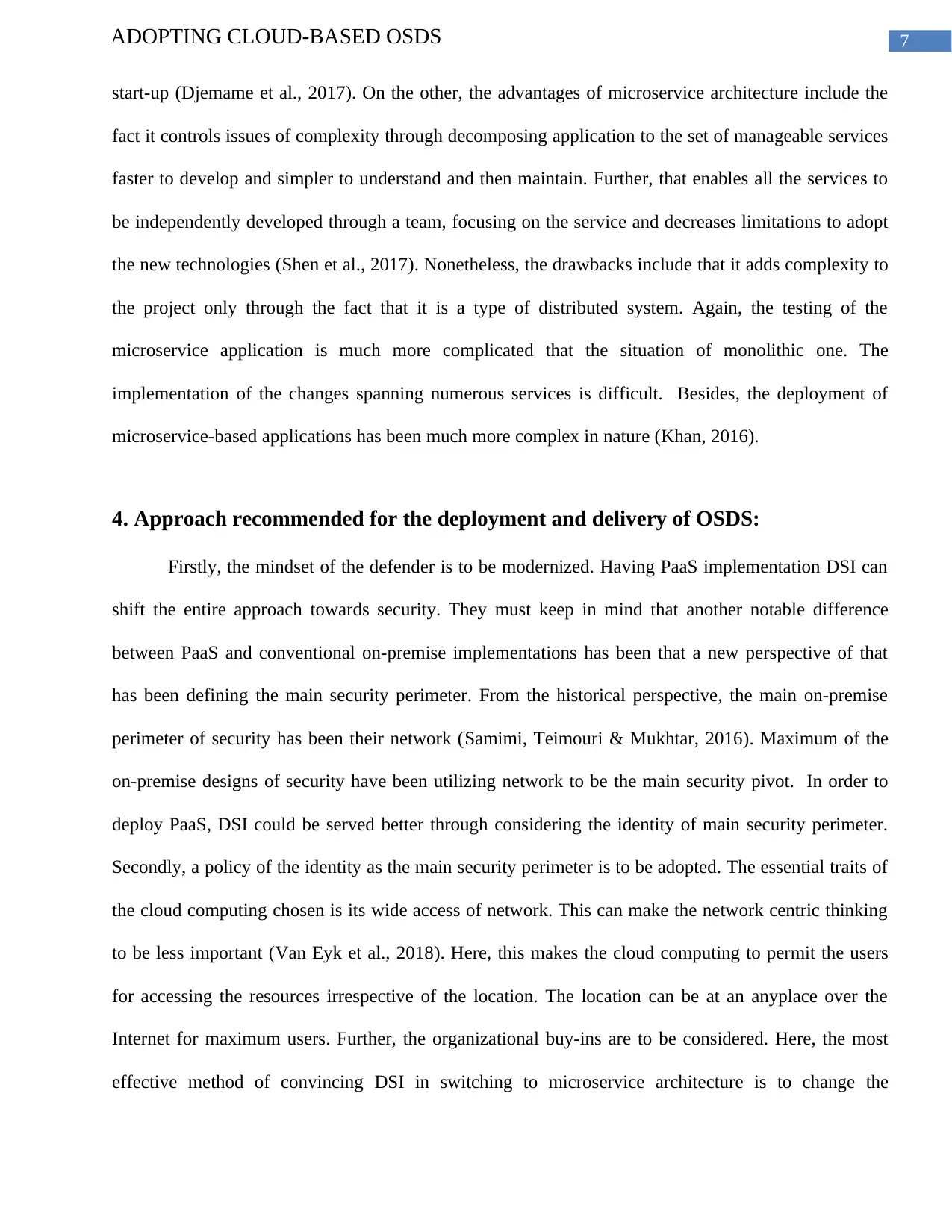
7ADOPTING CLOUD-BASED OSDS
start-up (Djemame et al., 2017). On the other, the advantages of microservice architecture include the
fact it controls issues of complexity through decomposing application to the set of manageable services
faster to develop and simpler to understand and then maintain. Further, that enables all the services to
be independently developed through a team, focusing on the service and decreases limitations to adopt
the new technologies (Shen et al., 2017). Nonetheless, the drawbacks include that it adds complexity to
the project only through the fact that it is a type of distributed system. Again, the testing of the
microservice application is much more complicated that the situation of monolithic one. The
implementation of the changes spanning numerous services is difficult. Besides, the deployment of
microservice-based applications has been much more complex in nature (Khan, 2016).
4. Approach recommended for the deployment and delivery of OSDS:
Firstly, the mindset of the defender is to be modernized. Having PaaS implementation DSI can
shift the entire approach towards security. They must keep in mind that another notable difference
between PaaS and conventional on-premise implementations has been that a new perspective of that
has been defining the main security perimeter. From the historical perspective, the main on-premise
perimeter of security has been their network (Samimi, Teimouri & Mukhtar, 2016). Maximum of the
on-premise designs of security have been utilizing network to be the main security pivot. In order to
deploy PaaS, DSI could be served better through considering the identity of main security perimeter.
Secondly, a policy of the identity as the main security perimeter is to be adopted. The essential traits of
the cloud computing chosen is its wide access of network. This can make the network centric thinking
to be less important (Van Eyk et al., 2018). Here, this makes the cloud computing to permit the users
for accessing the resources irrespective of the location. The location can be at an anyplace over the
Internet for maximum users. Further, the organizational buy-ins are to be considered. Here, the most
effective method of convincing DSI in switching to microservice architecture is to change the
start-up (Djemame et al., 2017). On the other, the advantages of microservice architecture include the
fact it controls issues of complexity through decomposing application to the set of manageable services
faster to develop and simpler to understand and then maintain. Further, that enables all the services to
be independently developed through a team, focusing on the service and decreases limitations to adopt
the new technologies (Shen et al., 2017). Nonetheless, the drawbacks include that it adds complexity to
the project only through the fact that it is a type of distributed system. Again, the testing of the
microservice application is much more complicated that the situation of monolithic one. The
implementation of the changes spanning numerous services is difficult. Besides, the deployment of
microservice-based applications has been much more complex in nature (Khan, 2016).
4. Approach recommended for the deployment and delivery of OSDS:
Firstly, the mindset of the defender is to be modernized. Having PaaS implementation DSI can
shift the entire approach towards security. They must keep in mind that another notable difference
between PaaS and conventional on-premise implementations has been that a new perspective of that
has been defining the main security perimeter. From the historical perspective, the main on-premise
perimeter of security has been their network (Samimi, Teimouri & Mukhtar, 2016). Maximum of the
on-premise designs of security have been utilizing network to be the main security pivot. In order to
deploy PaaS, DSI could be served better through considering the identity of main security perimeter.
Secondly, a policy of the identity as the main security perimeter is to be adopted. The essential traits of
the cloud computing chosen is its wide access of network. This can make the network centric thinking
to be less important (Van Eyk et al., 2018). Here, this makes the cloud computing to permit the users
for accessing the resources irrespective of the location. The location can be at an anyplace over the
Internet for maximum users. Further, the organizational buy-ins are to be considered. Here, the most
effective method of convincing DSI in switching to microservice architecture is to change the
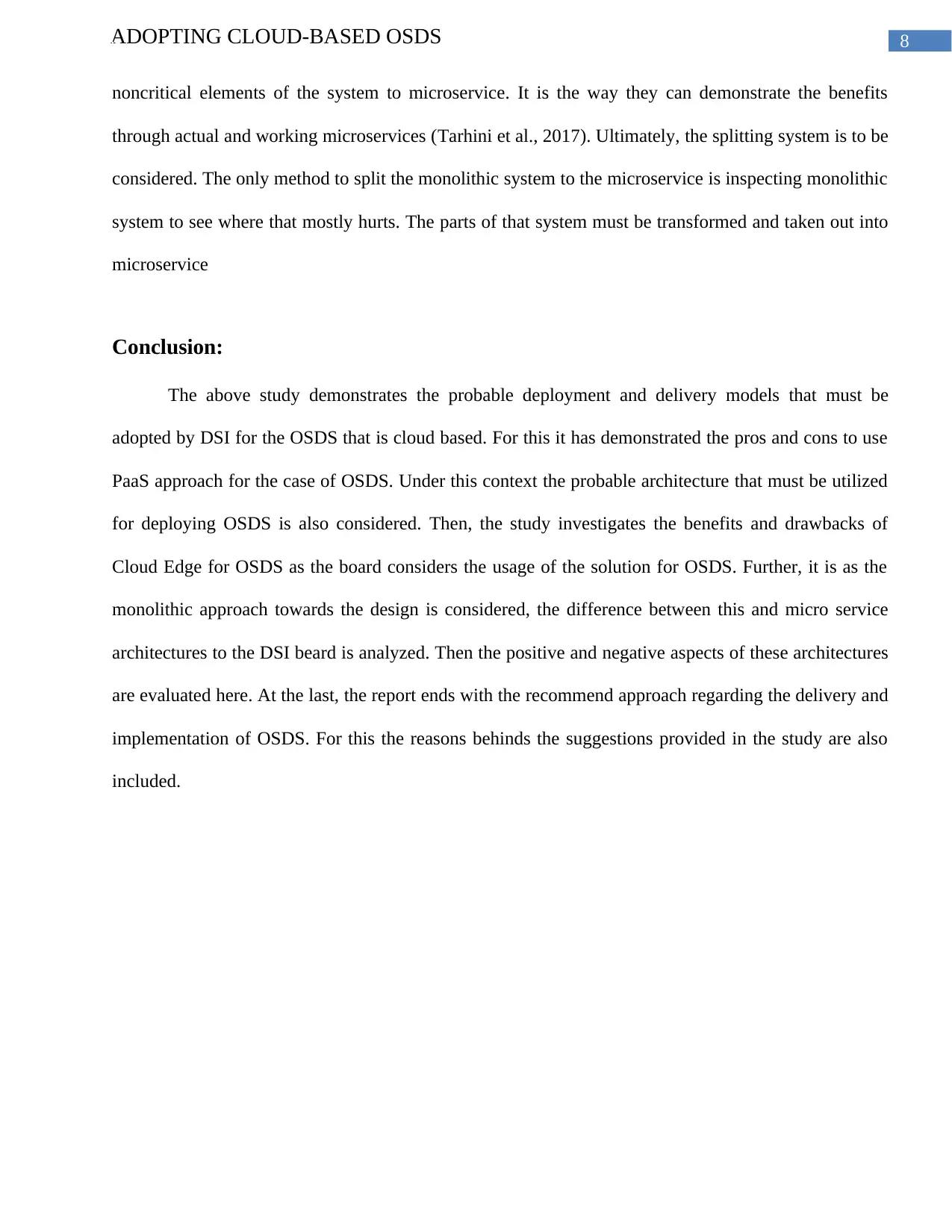
8ADOPTING CLOUD-BASED OSDS
noncritical elements of the system to microservice. It is the way they can demonstrate the benefits
through actual and working microservices (Tarhini et al., 2017). Ultimately, the splitting system is to be
considered. The only method to split the monolithic system to the microservice is inspecting monolithic
system to see where that mostly hurts. The parts of that system must be transformed and taken out into
microservice
Conclusion:
The above study demonstrates the probable deployment and delivery models that must be
adopted by DSI for the OSDS that is cloud based. For this it has demonstrated the pros and cons to use
PaaS approach for the case of OSDS. Under this context the probable architecture that must be utilized
for deploying OSDS is also considered. Then, the study investigates the benefits and drawbacks of
Cloud Edge for OSDS as the board considers the usage of the solution for OSDS. Further, it is as the
monolithic approach towards the design is considered, the difference between this and micro service
architectures to the DSI beard is analyzed. Then the positive and negative aspects of these architectures
are evaluated here. At the last, the report ends with the recommend approach regarding the delivery and
implementation of OSDS. For this the reasons behinds the suggestions provided in the study are also
included.
noncritical elements of the system to microservice. It is the way they can demonstrate the benefits
through actual and working microservices (Tarhini et al., 2017). Ultimately, the splitting system is to be
considered. The only method to split the monolithic system to the microservice is inspecting monolithic
system to see where that mostly hurts. The parts of that system must be transformed and taken out into
microservice
Conclusion:
The above study demonstrates the probable deployment and delivery models that must be
adopted by DSI for the OSDS that is cloud based. For this it has demonstrated the pros and cons to use
PaaS approach for the case of OSDS. Under this context the probable architecture that must be utilized
for deploying OSDS is also considered. Then, the study investigates the benefits and drawbacks of
Cloud Edge for OSDS as the board considers the usage of the solution for OSDS. Further, it is as the
monolithic approach towards the design is considered, the difference between this and micro service
architectures to the DSI beard is analyzed. Then the positive and negative aspects of these architectures
are evaluated here. At the last, the report ends with the recommend approach regarding the delivery and
implementation of OSDS. For this the reasons behinds the suggestions provided in the study are also
included.

9ADOPTING CLOUD-BASED OSDS
References:
Abdel-Basset, M., Mohamed, M., & Chang, V. (2018). NMCDA: A framework for evaluating cloud
computing services. Future Generation Computer Systems, 86, 12-29.
Díaz, M., Martín, C., & Rubio, B. (2016). State-of-the-art, challenges, and open issues in the
integration of Internet of things and cloud computing. Journal of Network and Computer
applications, 67, 99-117.
Djemame, K., Bosch, R., Kavanagh, R., Alvarez, P., Ejarque, J., Guitart, J., & Blasi, L. (2017). Paas-
iaas inter-layer adaptation in an energy-aware cloud environment. IEEE Transactions on
Sustainable Computing, 2(2), 127-139.
Gai, K., Qiu, M., Zhao, H., Tao, L., & Zong, Z. (2016). Dynamic energy-aware cloudlet-based mobile
cloud computing model for green computing. Journal of Network and Computer Applications,
59, 46-54.
Hussein, N. H., & Khalid, A. (2016). A survey of Cloud Computing Security challenges and solutions.
International Journal of Computer Science and Information Security, 14(1), 52.
Khan, M. A. (2016). A survey of security issues for cloud computing. Journal of network and computer
applications, 71, 11-29.
Kritikos, K., Kirkham, T., Kryza, B., & Massonet, P. (2017). Towards a security-enhanced PaaS
platform for multi-cloud applications. Future Generation Computer Systems, 67, 206-226.
Samimi, P., Teimouri, Y., & Mukhtar, M. (2016). A combinatorial double auction resource allocation
model in cloud computing. Information Sciences, 357, 201-216.
References:
Abdel-Basset, M., Mohamed, M., & Chang, V. (2018). NMCDA: A framework for evaluating cloud
computing services. Future Generation Computer Systems, 86, 12-29.
Díaz, M., Martín, C., & Rubio, B. (2016). State-of-the-art, challenges, and open issues in the
integration of Internet of things and cloud computing. Journal of Network and Computer
applications, 67, 99-117.
Djemame, K., Bosch, R., Kavanagh, R., Alvarez, P., Ejarque, J., Guitart, J., & Blasi, L. (2017). Paas-
iaas inter-layer adaptation in an energy-aware cloud environment. IEEE Transactions on
Sustainable Computing, 2(2), 127-139.
Gai, K., Qiu, M., Zhao, H., Tao, L., & Zong, Z. (2016). Dynamic energy-aware cloudlet-based mobile
cloud computing model for green computing. Journal of Network and Computer Applications,
59, 46-54.
Hussein, N. H., & Khalid, A. (2016). A survey of Cloud Computing Security challenges and solutions.
International Journal of Computer Science and Information Security, 14(1), 52.
Khan, M. A. (2016). A survey of security issues for cloud computing. Journal of network and computer
applications, 71, 11-29.
Kritikos, K., Kirkham, T., Kryza, B., & Massonet, P. (2017). Towards a security-enhanced PaaS
platform for multi-cloud applications. Future Generation Computer Systems, 67, 206-226.
Samimi, P., Teimouri, Y., & Mukhtar, M. (2016). A combinatorial double auction resource allocation
model in cloud computing. Information Sciences, 357, 201-216.
Paraphrase This Document
Need a fresh take? Get an instant paraphrase of this document with our AI Paraphraser
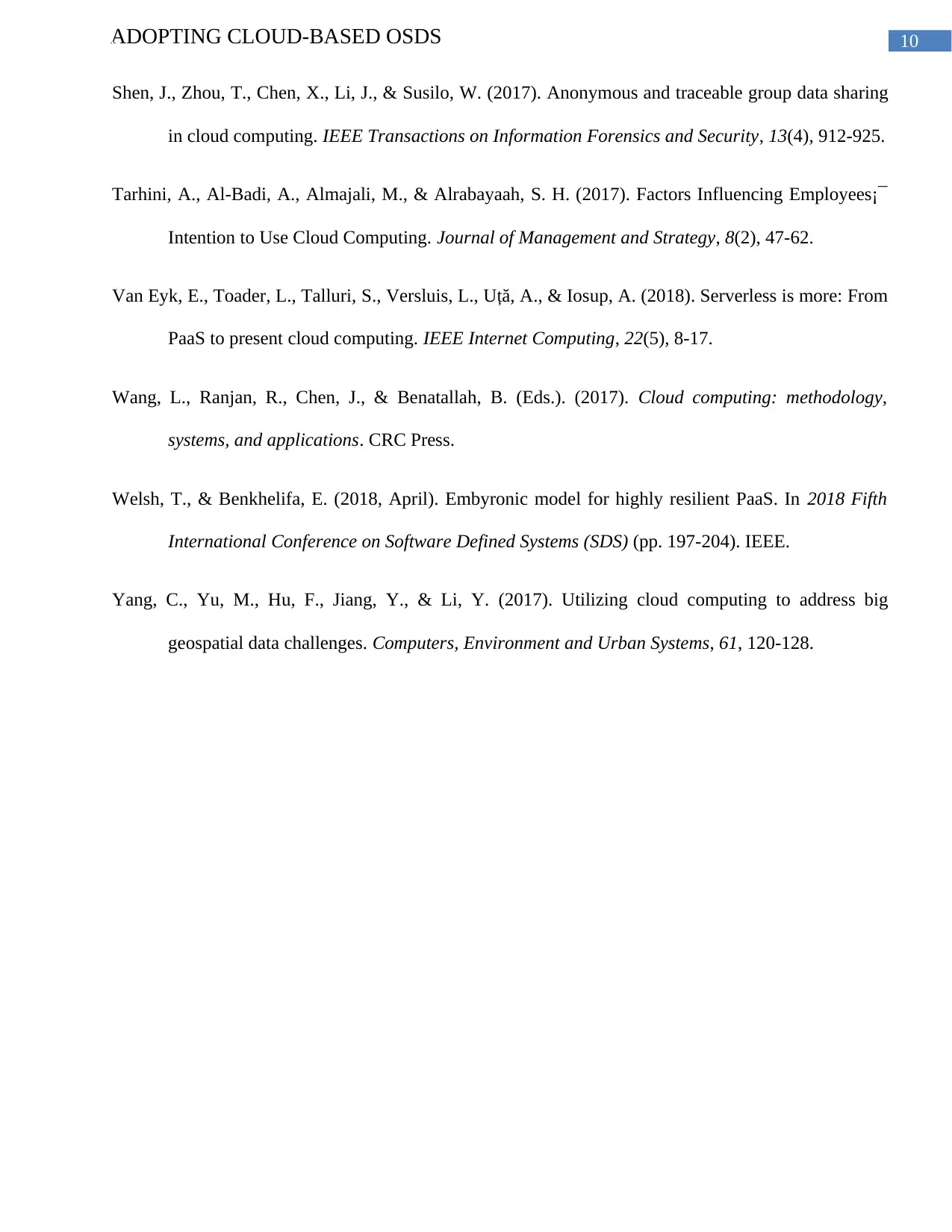
10ADOPTING CLOUD-BASED OSDS
Shen, J., Zhou, T., Chen, X., Li, J., & Susilo, W. (2017). Anonymous and traceable group data sharing
in cloud computing. IEEE Transactions on Information Forensics and Security, 13(4), 912-925.
Tarhini, A., Al-Badi, A., Almajali, M., & Alrabayaah, S. H. (2017). Factors Influencing Employees¡¯
Intention to Use Cloud Computing. Journal of Management and Strategy, 8(2), 47-62.
Van Eyk, E., Toader, L., Talluri, S., Versluis, L., Uță, A., & Iosup, A. (2018). Serverless is more: From
PaaS to present cloud computing. IEEE Internet Computing, 22(5), 8-17.
Wang, L., Ranjan, R., Chen, J., & Benatallah, B. (Eds.). (2017). Cloud computing: methodology,
systems, and applications. CRC Press.
Welsh, T., & Benkhelifa, E. (2018, April). Embyronic model for highly resilient PaaS. In 2018 Fifth
International Conference on Software Defined Systems (SDS) (pp. 197-204). IEEE.
Yang, C., Yu, M., Hu, F., Jiang, Y., & Li, Y. (2017). Utilizing cloud computing to address big
geospatial data challenges. Computers, Environment and Urban Systems, 61, 120-128.
Shen, J., Zhou, T., Chen, X., Li, J., & Susilo, W. (2017). Anonymous and traceable group data sharing
in cloud computing. IEEE Transactions on Information Forensics and Security, 13(4), 912-925.
Tarhini, A., Al-Badi, A., Almajali, M., & Alrabayaah, S. H. (2017). Factors Influencing Employees¡¯
Intention to Use Cloud Computing. Journal of Management and Strategy, 8(2), 47-62.
Van Eyk, E., Toader, L., Talluri, S., Versluis, L., Uță, A., & Iosup, A. (2018). Serverless is more: From
PaaS to present cloud computing. IEEE Internet Computing, 22(5), 8-17.
Wang, L., Ranjan, R., Chen, J., & Benatallah, B. (Eds.). (2017). Cloud computing: methodology,
systems, and applications. CRC Press.
Welsh, T., & Benkhelifa, E. (2018, April). Embyronic model for highly resilient PaaS. In 2018 Fifth
International Conference on Software Defined Systems (SDS) (pp. 197-204). IEEE.
Yang, C., Yu, M., Hu, F., Jiang, Y., & Li, Y. (2017). Utilizing cloud computing to address big
geospatial data challenges. Computers, Environment and Urban Systems, 61, 120-128.
1 out of 11
![[object Object]](/_next/static/media/star-bottom.7253800d.svg)





